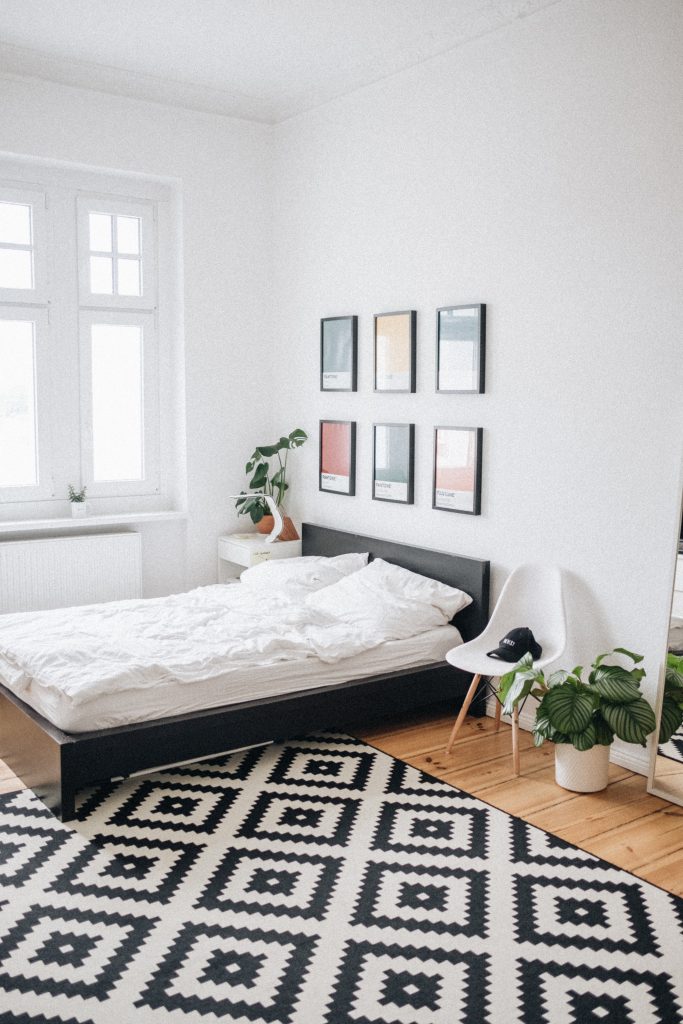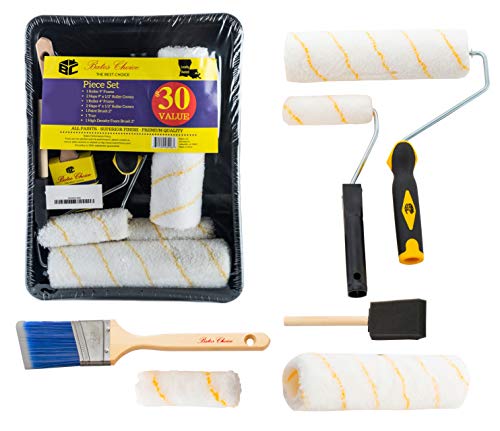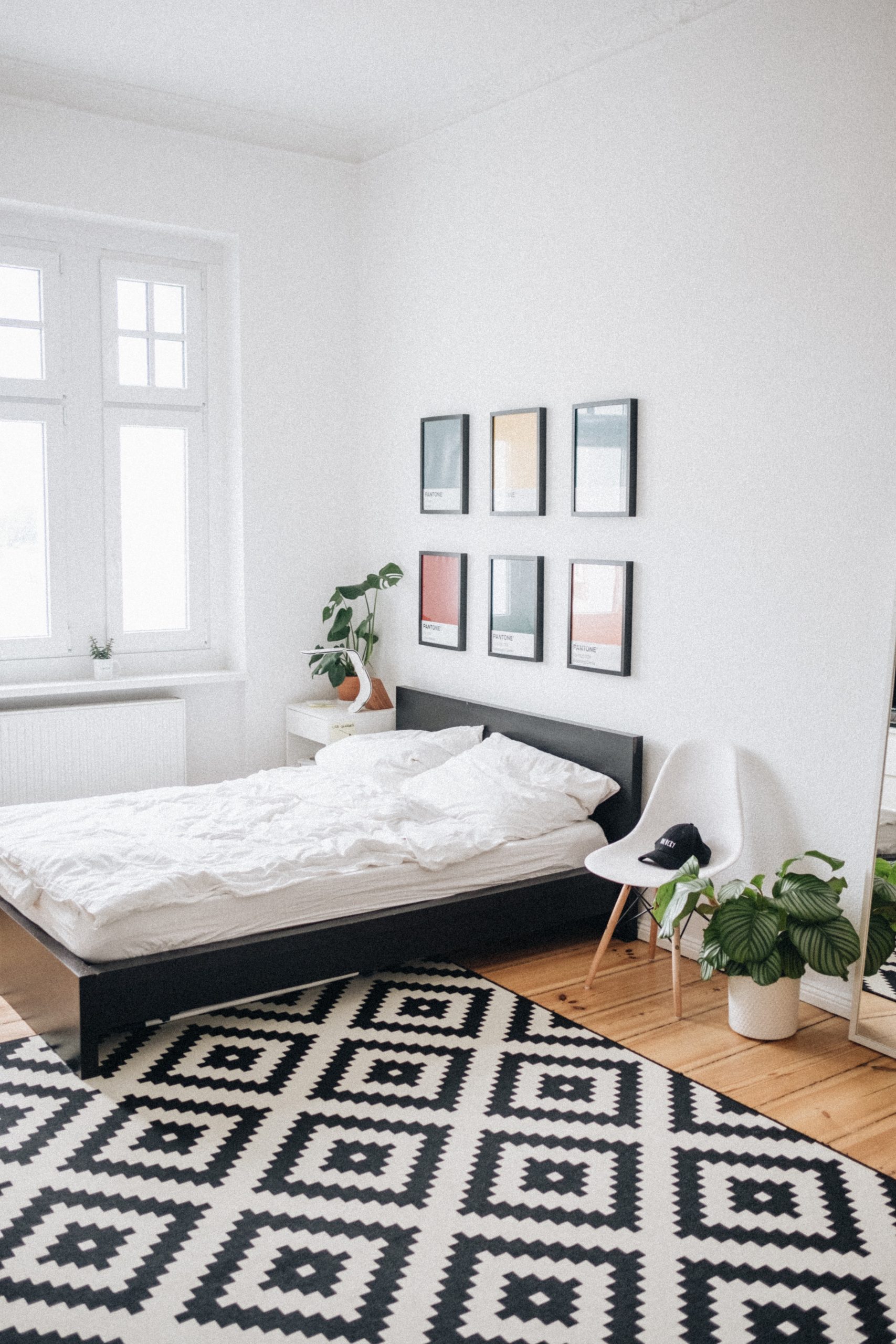How To Paint A Bedroom — The Complete Beginner’s Guide
Alright! So you just moved into a new room and you want to give it a personal touch. Or perhaps you just want to give your old room a new touch. Whatever the reason be, in this article, we’re going to teach you how to paint a room like a professional.

Table of Contents
Before Painting Your Room
Before you start painting your room, there are some things that you have to first consider. In this section of this article, we would be looking at those things:
What Colors Should You Use?
Of course, before you decide to paint your room, you have to first decide what colors you want to paint your room. It is important to get the colors beforehand as this information would help you know how much prep your walls would need before you start painting.
For example, if your room was colored with a dark color and you want to switch it to a brighter color, you might need more than one layer of paint to cover up the darker color. On the other hand, if you’re switching from a bright color to a darker color, one layer should be enough.
If you don’t know what color you want to paint your room, worry not. It’s super normal to be feeling this way. And thankfully, we have a solution for you.
The video below gives you the science and art behind choosing colors for your home. We suggest that you watch the video as it would show you the various things to put into consideration when picking the perfect paint color. This would make it a lot easier for you to pick a paint color or colors for your room.
Think About The Results
After picking out the colors that you want to use, the next thing to do is to create a mental picture of what you want the finished room to end up looking like.
If you don’t know what you want your room to look like, or you’re just looking for some more ideas, then we suggest you watch the video below.
The video features different unique wall painting ideas for a room. It’ll show you the beauty of accent walls, combining different colors on different walls, and so on. We strongly suggest you watch it. Even if you already know what you want to do, a few more ideas never hurt anybody.
Get Your Tools
Now that you’re done with the first two steps, getting your tools is the next step. Since you already know the colors you want for your wall and the different styles you might want, this should be easy.
Choosing The Right Paint — How To Paint A Room
Choosing the right paint is not just about color. Apart from the difference in colors, there are also different types of paints. These different types of paints all have their advantages and disadvantages, as we would soon see.
When painting your room. we suggest you opt for indoor paints. Yes, there are indoor paints and outdoor paints. Outdoor paints are usually coated with chemicals that defend them against the elements.
However, these chemicals might be harmful, if you use them indoors This is because you would constantly inhale them when you’re in your room.
So, the better option is indoor paint. Now for indoor paints, there are also various types. However, there are only two we recommend. Water-based paints, and oil-based paints.
These two usually don’t have harmful chemicals. Apart from that, they are also clean easily, which is something you want for a bedroom wall.
Water-based Paints Vs Oil-based Paints
Choosing between water-based paints and oil-based paints is another dilemma. On one hand, water-based paints are really low in chemicals. Also, they’re quick-drying and because they’re low in chemicals, they don’t smell.
However, the problem with using water-based paint is that they would not stick properly if the wall was previously painted with oil-based paint.
So, if it’s a new room, we strongly recommend water-based paint. However, if the room has already been previously painted with oil-based paint, then you would, unfortunately, have to continue with oil-based paints.
But oil-based paints are not terrible by any means. Yes, they do have strong fumes because of the presence of some chemicals. But apart from that, they are really good and have a beautiful glossy finish.
They’re also very durable and can be used in places like bathrooms and kitchens that have high humidity. Furthermore, as a beginner, you can benefit from its long drying time. A longer drying time means you have the opportunity to make needed changes before the paint dries.
If you don’t have the money for either oil or water-based paints, then latex-based paints are another option. However, we must warn you that these are not nearly as durable as both oil and water-based paints.
How Much Paint Is Required When Painting A Room?
Before painting a room, you have to determine how much paint will be needed. This will ensure that you don’t overspend and get more than you need, or underspend and get less.
First, you’ll have to properly measure your walls and ceiling first. Measure the height first, and then measure the width. Then multiply these two numbers together. This would give you the area of the wall. Don’t forget to do the same thing for your ceiling.
Now that you have the needed measurements, it’s time to buy the paint. You’ll need a gallon of paint for every 400 square feet (37 meters squared). One gallon should measure about 3.8 liters, depending on where you reside.
Remember that we mentioned earlier that if you’re trying to cover up a different color of paint, you would need slightly more paint. If it’s a textured wall, you’ll also need slightly more paint than normal.
If these measurements are confusing, then just use a Paint Calculator. It’ll provide you with certain boxes to input the measurements you’ve made around your room. Once you click calculate, it shows you a number, which is the amount of paint that’s required.
It’s really helpful and definitely something you should check out if you don’t know the amount of paint that’s required. Click here to check out a Paint Calculator.
Other Tools You Would Need Are:
- A Paint Brush
- A foam brush (optional)
- A paint roller
- An extension pole for the roller
- Some drop cloths
- A paint tray
- Sandpaper
- Some painter’s tape
- Putty Knife
We highly suggest that you check the Bates Paint Toolkit. It features most of the tools needed for painting walls in one kit. This makes it a lot easier to gather your tools as you won’t have to buy all of them individually.
The Bates Paint Toolkit comes with 11 different paint supplies. These include a paint roller, a paint tray, a paint brush, a foam brush, and some roller covers.
Prepping The Room For Painting
Now that you’ve gotten everything you need and you know what you want to do, it’s time to prep the room.
Remove all the furniture from the room and then cover the remaining things you can’t move out with a plastic sheet. If you do not have the space to move all your furniture to then move everything to the center and cover it with a plastic sheet.
After that, use a painter’s tape to cover all the edges of the wall so that paint doesn’t roll over from one wall to another. Use a good tape with a tight seal to ensure that paint doesn’t go under the seal.
We recommend using ScotchBlue Multi-Surface Painter’s Tape as it has a really tight fit.
Click this link to buy yours now!
Also, use the painter’s tape to cover all the electrical outlets and other small things you don’t want to paint around.
Wash And Clean The Walls
Now that you’ve gotten everything out, you’ll have to clean the walls thoroughly first. Use a wall-cleaner like Trisodium Phosphate and some drop cloths to clean the painting on wall. It helps to cut through grease and dust. This helps the paint to stick better to the walls.
Where the dirt is acting tough a putty knife is your greatest weapon. With a putty knife, you’ll be able to scrape out the tougher dirt and stains on the walls.
Make sure to cover your hands with gloves and also wear long-sleeved cloth. TSP can cause skin irritations so it’s best if they do not have direct contact with the skin.
Make Sure The Room Is Properly Ventilated
When painting a room, it’s important you open all the windows and doors. This allows the paint to dry faster and prevents you from choking on its fumes.
It would also be a good idea to use a sheen or mesh covering for the windows so things like dust and insects won’t be able to get in. If you don’t have, then keep the windows closed, and put on an air conditioner or a fan.
Sand Down The Walls (Optional)
If the previous paint you had on the walls had a high-gloss finish, you might have to first sand-paper it. If you don’t the new paint will have a hard time sticking to the wall.
When doing this, make sure that you don’t overdo it. You don’t want to file down the wall such that it starts looking uneven. All you want is to remove the glossy feel such that the paint sticks much better when painted on.
Apply Primer (Optional)
If you have an unpainted wall or a painted wall with several patches, then you would have to apply a primer before painting. If the wall has been painted before but you want to change the color drastically, mainly from a darker color to a lighter one, you’ll need a primer.
However, if you’re only repainting the same color or painting a darker color over a lighter one, you might not have to apply primer.
For painted walls that only have unpainted patches, you only have to apply the primer on those patches, using your brush.
Painting The Walls — How To Paint A Room
Stir The Paint
Open the bucket of paint and stir it thoroughly. You can do this with your brush or roller. Over time, paint in a bucket will begin to settle at the bottom. If you don’t stir it properly before you begin, the color would be more concentrated at the bottom. This is definitely not what you want.
Choose Your Technique
There are a lot of different painting techniques. In order to get a consistent look throughout the room, find the best and most comfortable for you and stick with it.
If you don’t know about painting techniques, then we suggest you watch the video below. It features the best painting techniques on how to paint a wall for beginners and should give you an idea of what works and what doesn’t.
Paint Away
Now that you’ve gotten the technique that works for you, it’s time to paint away! Don’t forget to paint the ceiling first. If you don’t start with the ceiling, then when you’re painting the ceiling, drops of paint will fall on your already painted wall.
After the ceiling, paint the trim first. If you paint the trim first with a brush, it’ll be much easier to go through the rest of the wall with a roller.
Conclusion — How To Paint A Room
Once you’re done painting, don’t forget to clean up immediately. If you wait too long, the paint would dry and become difficult to remove. Wipe the floors with drop cloths and the TSP from earlier. Also keep your paint brush, foam brush, and rollers clean.
Also, if at any point during the painting you become nauseated, take a break. The fumes from paints can often cause this. So, the best thing to do is to go outside or open a window to get fresh air. Wait until you get comfortable before going back in again.
We leave you with 5 professional painting hacks, enjoy!

